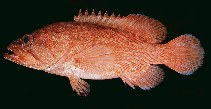|
Cephalopholis aitha Randall & Heemstra, 1991 Rusty hind |

|
|
photo by
Randall, J.E. |
| Family: | Epinephelidae (Groupers) | |||
| Max. size: | 25 cm TL (male/unsexed) | |||
| Environment: | reef-associated; marine; depth range 5 - 33 m, non-migratory | |||
| Distribution: | Western Pacific: Philippines, Indonesia (Sulawesi, Flores), and Papua New Guinea. | |||
| Diagnosis: | Dorsal spines (total): 9-9; Dorsal soft rays (total): 14-14; Anal spines: 3-3; Anal soft rays: 8-8. Similar to the more common Cephalopholis spiloparaea but lacks banding in the caudal fin (Ref. 48635); characterized further by reddish brown color; base of pelvic fins with indistinct dark blotch; greatest body depth 2.5-2.9 in SL; rounded caudal fin; short pelvic fins, 2.3-2.5 in head length; strongly bilobed margin of front of upper lip (Ref. 90102); head length 2.1-2.3 times in SL; rounded preopercle, posterior edge finely serrate, lower edge fleshy; very convex upper edge of operculum; maxilla extends past eye; teeth large; midlateral-body scales ctenoid (Ref. 89707). | |||
| Biology: | Inhabits protected or silty reef areas (Ref. 89707). Reported to be very habitat speciific, lives in very rich invertebrate habitat in the shore side of inner reefs and difficult to get shots u/w. Largest seen was about 25 cm, but usually smaller up to about 20 cm (R. Kuiter, pers. Comm. 03/2022). Maximum length given 40 cm TL (for confirmation) May undergo protogyny. Solitary (Ref 90102). | |||
| IUCN Red List Status: | Least Concern (LC); Date assessed: 18 November 2016 Ref. (130435) | |||
| Threat to humans: | harmless | |||